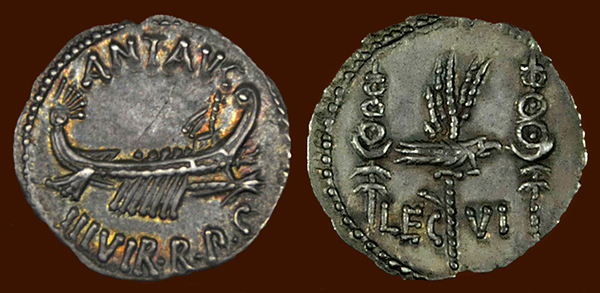Obv. ANT AVG III VIR R P C. Galley to the right with banners at the prow; Rev. LEG VI. Eagle (aquila) facing right between two legionary standards (signa). Reference: BMC 197, RSC 33, Sear 356.
This iconic legionary denarius was struck by Mark Antony, likely at Patrae on the northwest coast of Greece where he passed the winter preparing to confront Octavian at Actium in September 31 BC. With a lower silver content (copper having been added to the alloy), these coins tended not to be hoarded but remained in circulation for hundreds of years. As a result, they often are found in very worn condition or with bankers' assay marks.
Above the galley on the obverse are the letters ANT AVG, abbreviating Antonius Augurus. Caesar had held the augurate and Antony sought to identify himself with the same distinction. Below, the letters III VIR·R·P·C signify Tresviri Rei Publicae Constituendae, which had been established in 43 BC by the Lex Titia. It gave Antony, Octavian, and an inconsequential Lepidus (the Second Triumvirate) supreme authority in managing the Roman state. Charged with "constituting" the res publica, the men were, in the words of Dio, to be "commissioners and correctors of a sort, for the administration and settlement of affairs" (Roman History, XLVI.55.3). If he struggles with the phrasing, it is to avoid the word "dictator," the despised title having been abolished after Caesar's death (Livy, Periochae, CXVI.7).
Although many of the original coins still were in circulation, Marcus Aurelius and Lucius Verus marked the two-hundredth anniversary of the Battle of Actium was a reissue in AD 169, all of which honored only Legio VI. By then, ANT was associated with the name of Antoninus Pius, and AVG, the abbreviation for Augustus and his imperial successors. To avoid confusion, these restitutions (reissues) spelled the words in full, ANTONIVS AVGVR.
On the reverse is abbreviated LEG VI. Levied by Caesar, Legio VI Ferrata ("Ironclad") saw its first action against Vercingetorix at the siege of Alesia in Gaul (52 BC) and later fought against Pompey at the Battle of Pharsalus (48 BC). The legion almost was annihilated the next year when, pursuing Pompey to Alexandria, it was besieged by the forces of Ptolemy XIII (Caesar, Civil Wars, III.106). Caesar triumphed (and secured the throne for Cleopatra)—but with reinforcements from Mithridates of Pergamon, who allied with him at the final Battle of the Nile in 47 BC. Only two cohorts (fewer than a thousand men) of Legio VI survived to fight in the Battle of Zela later that year against Pharnaces II, where they were instrumental in victory (Alexandrian War, LXXVI; commemorated with Caesar's words Veni, vidi, vici, which "have the same inflectional ending, and so a brevity which is most impressive," Plutarch, Life of Julius Caesar, L.4). Following the assassination of Caesar in 44 BC, the legionaries, who by then were colonists in Arles, were reformed by Lepidus and given over to Antony the following year in his pursuit of Brutus and Cassius, where they fought at the decisive Battle of Philippi (42 BC).
Flanked by standards (signa) of the legionary cohorts, their staffs adorned with disks (phalera) and crescents, is the legionary eagle (aquila). It had been established in 104 BC when Gaius Marius, as part of his military reform, "assigned the eagle exclusively to the Roman legions" (Pliny, Natural History, X.v.16). Symbolic of the legion's honor, the eagle was fiercely protected. Once, at the legendary Battle of Lake Regillus centuries before (in which Castor and Pollux themselves were said to have ridden over the battlefield), the commander "adopted the new and remarkable stratagem of hurling a standard among the enemy, in order that it might be recovered" (Florus, Epitome of Roman History, I.11..2–4).
To be sure, if an eagle was lost in battle, Rome was tenacious in its recovery. One aquilifer, before being cut down, threw his to safety behind the ramparts (Caesar, Gallic War, V.37; Titus Pullo and Lucius Vorenus, "two most gallant centurions," are mentioned several chapters later, in V.44—and star in the HBO series Rome). In the Third Servile War (73–71 BC) against Spartacus, five eagles were recovered (Frontinus, Stratagems, II.5.34). Of the seven that had been lost to the Parthians at the disastrous Battle of Carrhae in 53 BC, three were returned after a treaty was negotiated in 20 BC by Augustus, who also secured the eagles lost by Antony in 40 and 36 BC (Res Gestae, XXIX). In AD 9, three legions were annihilated by German tribes at Teutoburg Forest. These eagles were recaptured as well, two almost a decade later (Tacitus, The Annals, I.60, 2.25) and the third in AD 41 (Dio, Roman History, LX.8.7).
A topographical note: Overlooking the narrows at the entrance to the Corinthian Gulf, Patrae was the port used by those traveling to Italy. Tiro, Cicero's freedman and friend, was convalescing there, sick with malaria. In corresponding, Cicero always admonished him to "Send a letter to me by everyone who is going to Italy, and I will not pass over anyone going to Patrae (Ad Familiares, XVI.6). Given its proximity to Italy, the port also was thought possibly to be an embarkation point for an invasion by Antony. Shortly before the Battle of Actium, however, it was captured by Agrippa (Dio, L.13.5). Actium, itself, is a promontory at the entrance to the Ambracian Gulf on which there was an ancient Temple of Apollo (Strabo, Geography, X.2.7; Dio, L.12.7).
See also Caesar and Cleopatra in Egypt.
